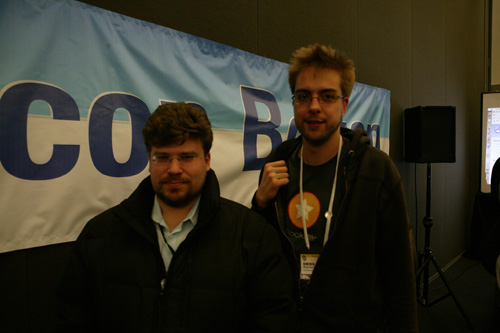Please help me to compile a list of ideas for web developer-appropriate tattoos. Here are some to get you started:
1) “It works on my machine”
2) “Have you flushed the browser cache?”
Blogging since 2002
Please help me to compile a list of ideas for web developer-appropriate tattoos. Here are some to get you started:
1) “It works on my machine”
2) “Have you flushed the browser cache?”
I find Jewish humor to be one of the best ways to explain certain situations in programming. Here are two that I find particularly funny and useful.
The first is a true story told me by a friend. I use it when I’m told that good web developers don’t use tables. It goes like this: My friend’s aunt met her religious relatives for the first time after coming to America from the Soviet Union. Horrified at being served pork sausage, they told her: “But auntie, Jews don’t eat pork!”. She replied — “Nonsense, I eat it all the time.”
The second is an old and racist Soviet-era joke. A Chukcha serves in the Soviet Army, and is an exemplary soldier in border patrol. There’s only one problem — he tends to eat patrol dogs, considering them a delicacy (this untrue ethnic detail must have been created to make the joke setup work). An army psychologist offers to correct this. He sits the soldier down, takes out his watch, and hypnotizes him with the words “you are not a Chukcha, you are a Jew. You don’t like to eat dogs, you like to eat gefilte fish.” The patrol dogs continue to vanish even after the hypnosis seems to have worked. Authorities send another soldier to follow the hypnotized Chukcha around. This soldier reports that the Chukcha sits the dogs down, takes out his watch and hypnotizes them with the words “You are not a dog, you are gefilte fish.” I tend to tell it when I’m told that the act of turning a hack into a Drupal module somehow makes it “gefilte fish.”
I frequently want to post images that don’t make a lot of sense to post in smaller format. I’ve been meaning to build a custom zoomer similar to Zoomfly, but gave up and just installed an off-the shelf module.
Here’s a sample file – a scan from a Soviet “Youth Technology” magazine circa 1961. A bought a couple of these on eBay – and I got to tell you, they really took me back… While growing up I was constantly reading back issues of these magazines, and now, in these few random issues that I purchased I found a few illustrations that I remembered, like the one that is at the end of this post. It’s a very strange feeling – remembering a picture last seen 20 years ago.
Another very strange feeling is noticing the lack of ads and Photoshoppery – all illustrations are either photographs or drawings, and they look so much better than what you’ll find in most todays magazines.
The article that accompanied this full page illustration was titled “Bourgeois Ideologists on the Future of Mankind” and was about doom and gloom that proliferated amongst western philosophers. In the illustration robots are going Abu Gharib on their creator’s ass, Martians are running for cover from Pentagon’s missiles, labour bosses are exploiting monkeys, dour looking generals are growing artificial goose-stepping soldiers, hippies are going back to stone age, and Malthusians are working on biological warfare. The top hat wearing capitalist monkey in the background is just darling.
Meanwhile, on the next page simple Soviet people are partying in the light of aurora Borealis.
Every time I am at a Kinokuniya bookstore, I deeply regret not being able to read Japanese.
Why does this book have two covers – with Hippie Bill and with Presidential Bill?

This book is amazing. I still regret not being able to part with $30 to get it, not only for the cover with the Twin Towers, but for the hand-drawn illustrations inside.

These days there are a lot of documentary shows on TV about various professions. I am somewhat addicted to them – I watched whole seasons of shows about hairdressers, crab fishermen, lobster fishermen, tattoo artists in Florida, tattoo artists in Nevada (but not the one about tattoo artists in LA), restaurateurs, ice road truck drivers, custom motorcycle builders, custom car builders, correctional officers and inmates, and the Philadelphia meter maids.
My own profession is mostly untelevisable. Mostly. Well, maybe some TV network might make a show out of Aardvark’d: 12 Weeks With Geeks. I also think that there could be a tiny market for a heavily edited “looking over the shoulder” video on the code writing habits of colorful alpha geeks like Linus Torvalds, Donald Knuth, Brad Fitzpatrick, Dries Buytaert, and maybe even JWZ. I’d buy that for a dollar.
I found that there are two occupations that are unexpectedly similar to that of a software developer: prison inmate and line cook. Both of these are heavily male dominated, involve a disproportionate amount of minorities and are very stressful.
I recognized offices in which I worked all my life in prison layouts. The common criminals usually live in a common area in the center of the prison. This is exactly like a common area of an office, except with bunk beds instead of desks. Some actually have semi-private cubicles. Inmates organize into gangs, just like departments. Gang leaders are usually placed into single or double cells that line the perimeter of the common area to cut down on the communication between them and their reports. Even there you have to be a manager to score an office.
Restaurants are a lot like developer shops. You have your front of the house: waiters (sales people), hosts and managers, food runners (analysts). And then you have your back of the house: chefs (architects and lead developers), line cooks (developers) and prep cooks (producers). There’s no good equivalent for dishwashers in a typical developer shop.
People often assume that a chef primarily cooks and a lead developer primarily codes. Do you know the title of Julia Child’s awesome show? Well, she was neither French nor a chef. Chefs do surprisingly little cooking, they are more like conductors in orchestras. They create menus, divvy up the tasks, check quality, train and supervise cooks. Best chefs, just like the best lead developers do find time to cook, but still spend more time organizing, tasting and researching.

My last two weeks were very intense. 12 hour days, a 30 hour coding session, a week in Boston with various very cool nerds, a ride in an Aston Martin, a tour of the Infinite Corridor. Will post more when I’ll have more time.

For those not in the know – Superstar is a company, I think they were purchased by TV Guide. In any case, they shared some office space at TV Guide headquarters in Tulsa, OK.
Slowly, but steadily I am getting a little better at latte art. Once I’ll figure it out completely, I’ll make a couple of videos and write a how-to article. Meanwhile, head over to youtube and look at some of the videos that they have of rosetta pours. Neat, eh?

“It’s the combination of narcissism and nihilism that really defines postmodernism” Al Gore
I am a man with huge gaps in education. Every time I think about all the history, philosophy and literature that I should be familiar with, I shudder. Take, for instance, Modern Library List of Best 20th-Century Novels. Out of the top 10 I olnly read numbers 4, 5 and 10.
By the way, Modern Library editors did not understand the web enough to run a poll for a reader selected top list. Of course, the list came to include 4 Ayn Rand and three L. Ron Hubbard titles, with two top spots going to “Atlas Shrugged” and “The Fountainhead,” and third to “Battlefield Earth”. I am a bit surprised to see the Objectivists defeat the Scientologists, but I guess they’ve heard about the vote earlier and mobilized their forces ahead of time somehow.
A similar “vote” happened on the TV Guide website once. The poll was run to determine the most annoying Star Trek character, and early on Ensign “Wussley” Crusher had a good lead on the competition. That was until Wussley’s alter ego, popular blogger Wil Wheaton, asked his readers to stuff the ballot box. Funnily enough, both wilwheaton.net and tvguide.com have the same PageRank of 7, so he had more than enough readers to rig the vote. I don’t remember who won and I can’t really look it up because in its recent redesign TV Guide broke most of the old urls (one of the reasons why its PageRank is so low).
Anyway, I really wanted to talk about the top Modern Library novel, Ulysses by James Joyce. I must have started this book 3 times, only to get stuck a couple of pages into it. I’ll have another go at it sometime, but I am afraid I am not smart enough yet to tackle it.
One thing that leads me to believe that there might be a day when I’ll enjoy Ulysses is my growing appreciation of the Modernist movement. Even though the contents of the book elude my understanding at this moment, I really like the dustjacket created by E. McKnight Kauffer and book design by Ernst Reichl. Just because of the dustjacket design I paid $15 for this book many years ago, when I usually refused to pay more than a buck for a used book. The elegance of the form and color, the expressiveness of the simple type elements is lightyears beyond the current, and I guess what should be called “Postmodern,” cover.


The funny thing is that “Modernism” is not modern at all. We are talking about books, architecture and music that is at least 50, and some times almost 100 years old. What comes after Modernism? Postmodernism. Honest to God, it looks like our society is running out of naming ideas. What do you name a language that comes after B? C. And then? C++. What comes after Generation X? Generation Y. Then? Generation Z.
The latest poll is about Wesley Crusher.
Several days ago I was startled by something in a post titled “moving up in “teh company”” in Livejournal’s Starbucks barrista community. The poster said:
“< insert typical “yay me, I’m being promoted to SS” comment here >
So I went to my learning coach class last night. It was very informative and good. I’ll begin official SS training about a week and a half from now.”
It took me a little while to realize that SS in Starbucksian jargon stands for Shift Supervisor, not Schutzstaffel. Over the years I got used to being asked for my SS (Social Security) number, but apparently when I hear “SS” in other contexts my first thought is still “Nazis!”.
This reminded me of a rumor that I’ve heard before. See, I’ve been told that that SS uniforms were so stylish because they were designed by Hugo Boss. It did not sound right – I thought that Hugo Boss is an American company, that was created after the war and that Hugo Boss is not a real person, but a created brand, like Mavis Beacon (see my post about that).
The first place I went to was hugoboss.com. Well, I was wrong, it’s a German company all right. But the website is missing “Company history” section. Suspicious. I mean, usually established companies are rather proud of their beginnings. Kennethcole.com, for instance, has a whole segment about how Kenneth Cole (he’s a real person, I’ve even met him once) hacked New York City rules by pretending to shoot a movie in order to gain valuable parking permit necessary to sell shoes out of a trailer. You can read all about it here.
So, I did a little digging of my own and guess what – according to Wikipedia, which in turn quotes Washington Post, Hugo Boss, the founder of the company did indeed design and manufacture Nazi uniforms, and on top of that likely used forced labour.
Here’s a picture from hugoboss.com:

And here’s one from Wikipedia that I doctored up a little (I changed the position of the guy on the right – the original is here)

Maybe Hugo Boss of today is very, very different from the WWII era one, but they do make some snappy clothes.